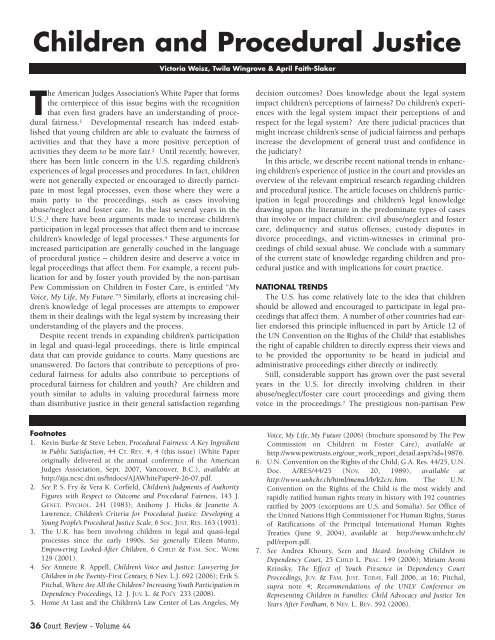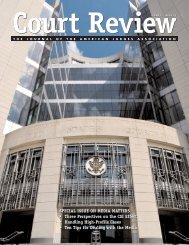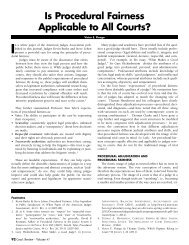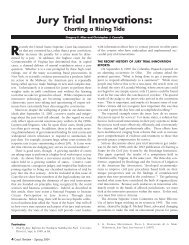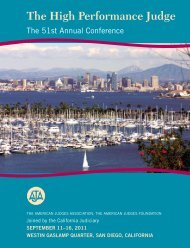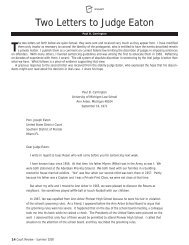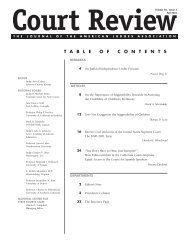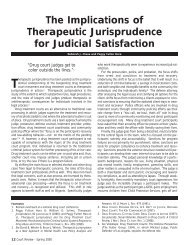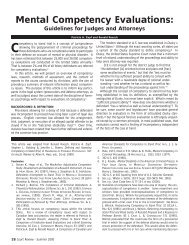Special Issue on Procedural Fairness - American Judges Association
Special Issue on Procedural Fairness - American Judges Association
Special Issue on Procedural Fairness - American Judges Association
- No tags were found...
Create successful ePaper yourself
Turn your PDF publications into a flip-book with our unique Google optimized e-Paper software.
Children and <strong>Procedural</strong> JusticeVictoria Weisz, Twila Wingrove & April Faith-SlakerThe <strong>American</strong> <strong>Judges</strong> Associati<strong>on</strong>’s White Paper that formsthe centerpiece of this issue begins with the recogniti<strong>on</strong>that even first graders have an understanding of proceduralfairness. 1 Developmental research has indeed establishedthat young children are able to evaluate the fairness ofactivities and that they have a more positive percepti<strong>on</strong> ofactivities they deem to be more fair. 2 Until recently, however,there has been little c<strong>on</strong>cern in the U.S. regarding children’sexperiences of legal processes and procedures. In fact, childrenwere not generally expected or encouraged to directly participatein most legal processes, even those where they were amain party to the proceedings, such as cases involvingabuse/neglect and foster care. In the last several years in theU.S., 3 there have been arguments made to increase children’sparticipati<strong>on</strong> in legal processes that affect them and to increasechildren’s knowledge of legal processes. 4 These arguments forincreased participati<strong>on</strong> are generally couched in the languageof procedural justice – children desire and deserve a voice inlegal proceedings that affect them. For example, a recent publicati<strong>on</strong>for and by foster youth provided by the n<strong>on</strong>-partisanPew Commissi<strong>on</strong> <strong>on</strong> Children in Foster Care, is entitled “MyVoice, My Life, My Future.” 5 Similarly, efforts at increasing children’sknowledge of legal processes are attempts to empowerthem in their dealings with the legal system by increasing theirunderstanding of the players and the process.Despite recent trends in expanding children’s participati<strong>on</strong>in legal and quasi-legal proceedings, there is little empiricaldata that can provide guidance to courts. Many questi<strong>on</strong>s areunanswered. Do factors that c<strong>on</strong>tribute to percepti<strong>on</strong>s of proceduralfairness for adults also c<strong>on</strong>tribute to percepti<strong>on</strong>s ofprocedural fairness for children and youth? Are children andyouth similar to adults in valuing procedural fairness morethan distributive justice in their general satisfacti<strong>on</strong> regardingdecisi<strong>on</strong> outcomes? Does knowledge about the legal systemimpact children’s percepti<strong>on</strong>s of fairness? Do children’s experienceswith the legal system impact their percepti<strong>on</strong>s of andrespect for the legal system? Are there judicial practices thatmight increase children’s sense of judicial fairness and perhapsincrease the development of general trust and c<strong>on</strong>fidence inthe judiciary?In this article, we describe recent nati<strong>on</strong>al trends in enhancingchildren’s experience of justice in the court and provides anoverview of the relevant empirical research regarding childrenand procedural justice. The article focuses <strong>on</strong> children’s participati<strong>on</strong>in legal proceedings and children’s legal knowledgedrawing up<strong>on</strong> the literature in the predominate types of casesthat involve or impact children: civil abuse/neglect and fostercare, delinquency and status offenses, custody disputes indivorce proceedings, and victim-witnesses in criminal proceedingsof child sexual abuse. We c<strong>on</strong>clude with a summaryof the current state of knowledge regarding children and proceduraljustice and with implicati<strong>on</strong>s for court practice.NATIONAL TRENDSThe U.S. has come relatively late to the idea that childrenshould be allowed and encouraged to participate in legal proceedingsthat affect them. A number of other countries had earlierendorsed this principle influenced in part by Article 12 ofthe UN C<strong>on</strong>venti<strong>on</strong> <strong>on</strong> the Rights of the Child 6 that establishesthe right of capable children to directly express their views andto be provided the opportunity to be heard in judicial andadministrative proceedings either directly or indirectly.Still, c<strong>on</strong>siderable support has grown over the past severalyears in the U.S. for directly involving children in theirabuse/neglect/foster care court proceedings and giving themvoice in the proceedings. 7 The prestigious n<strong>on</strong>-partisan PewFootnotes1. Kevin Burke & Steve Leben, <strong>Procedural</strong> <strong>Fairness</strong>: A Key Ingredientin Public Satisfacti<strong>on</strong>, 44 CT. REV. 4, 4 (this issue) (White Paperoriginally delivered at the annual c<strong>on</strong>ference of the <strong>American</strong><strong>Judges</strong> Associati<strong>on</strong>, Sept. 2007, Vancouver, B.C.), available athttp://aja.ncsc.dni.us/htdocs/AJAWhitePaper9-26-07.pdf.2. See P. S. Fry & Vera K. Corfield, Children’s Judgments of AuthorityFigures with Respect to Outcome and <strong>Procedural</strong> <strong>Fairness</strong>, 143 J.GENET. PSYCHOL. 241 (1983); Anth<strong>on</strong>y J. Hicks & Jeanette A.Lawrence, Children’s Criteria for <strong>Procedural</strong> Justice: Developing aYoung People’s <strong>Procedural</strong> Justice Scale, 6 SOC. JUST. RES. 163 (1993).3. The U.K. has been involving children in legal and quasi-legalprocesses since the early 1990s. See generally Eileen Munro,Empowering Looked-After Children, 6 CHILD & FAM. SOC. WORK129 (2001).4. See Annette R. Appell, Children’s Voice and Justice: Lawyering forChildren in the Twenty-First Century, 6 Nev. L.J. 692 (2006); Erik S.Pitchal, Where Are All the Children? Increasing Youth Participati<strong>on</strong> inDependency Proceedings, 12 J. JUV. L. & POL’Y 233 (2008).5. Home At Last and the Children’s Law Center of Los Angeles, MyVoice, My Life, My Future (2006) (brochure sp<strong>on</strong>sored by The PewCommissi<strong>on</strong> <strong>on</strong> Children in Foster Care), available athttp://www.pewtrusts.org/our_work_report_detail.aspx?id=19876.6. U.N. C<strong>on</strong>venti<strong>on</strong> <strong>on</strong> the Rights of the Child, G.A. Res. 44/25, U.N.Doc. A/RES/44/25 (NOV. 20, 1989), available athttp://www.unhchr.ch/html/menu3/b/k2crc.htm. The U.N.C<strong>on</strong>venti<strong>on</strong> <strong>on</strong> the Rights of the Child is the most widely andrapidly ratified human rights treaty in history with 192 countriesratified by 2005 (excepti<strong>on</strong>s are U.S. and Somalia). See Office ofthe United Nati<strong>on</strong>s High Commissi<strong>on</strong>er For Human Rights, Statusof Ratificati<strong>on</strong>s of the Principal Internati<strong>on</strong>al Human RightsTreaties (June 9, 2004), available at http://www.unhchr.ch/pdf/report.pdf.7. See Andrea Khoury, Seen and Heard: Involving Children inDependency Court, 25 CHILD L. PRAC. 149 (2006); Miriam Ar<strong>on</strong>iKrinsky, The Effect of Youth Presence in Dependency CourtProceedings, JUV. & FAM. JUST. TODAY, Fall 2006, at 16; Pitchal,supra note 4; Recommendati<strong>on</strong>s of the UNLV C<strong>on</strong>ference <strong>on</strong>Representing Children in Families: Child Advocacy and Justice TenYears After Fordham, 6 NEV. L. REV. 592 (2006).36 Court Review - Volume 44


